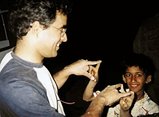


Whenever a natural disaster strikes, it seems the most vulnerable and worst affected are the children. Their physical wounds heal long before the emotional scars. The children who were orphaned, injured, traumatized, and left homeless by the Gujarat earthquake were no exception. Helping in their emotional rehabilitation and getting their education restarted were the main objectives of our second relief mission.
With the help of many dear friends and supporters in New Delhi, we put together another truckload of relief supplies—this time 1,000 school kits (each contained two notebooks, an art book, a box of crayons, pencils, erasers, a sharpener, and other art supplies), water tanks, half a ton of cooking oil, two tons of jaggery (raw sugar), and more rice, tea, milk powder, plastic mats, and clothes.
With great zest, children from a New Delhi school helped to pack the school materials into individual bags for the children of Naliya. When I asked one of the Class 5 boys what he was doing, he held up a school bag, flashed a wide grin that was minus two front teeth, and said proudly, “I’m helping the children go back to school!”
We arrived back in Naliya on March 14, and selected 12 villages where we felt the children needed the most help: Ustia, Bandiya, Jakhau, Sargwara, Mopatnagar, Wadsar, Gudthar, Lakhnia, Kuwapadhar, Aida, Haripar, and Ashapar. All of these villages had been almost completely destroyed in the earthquake, and the villagers were now living in tents and other temporary shelters.
In each village, we either helped to set up a school tent for the children, or, if it was still standing, arranged the use of the village community hall as a temporary school. Then we rounded up all the children, gave each one a school kit, and taught them an art class. We had never realized what a powerful therapeutic tool a humble crayon could be! It was as though the bright, happy colors that the children used to fill in their pencil sketches also brightened their lives and brought them new hope.
The art class done, we then taught them a simple Hindi song, which one of our drivers who was from that area translated in Kutchee. It was wonderful to see the children laughing and singing with gusto. Roughly translated into English, the song goes something like this:
In my heart, everywhere, I’m happy all the time.
In my heart, everywhere, I’m happy all the time.
When I give love and happiness to others,
I receive love and happiness myself, and I’m happy all the time.
Next we enacted a short drama entitled “The Rock in the Road,” which teaches unselfishness and concern for others. To end, we played a game of catch, dodge ball, or cricket with the children. The game often went late into the evening, as the children were never in a hurry to let us go!
In each village we gave the village schoolteachers a “teacher’s kit” containing more art supplies, stationery, and teaching aids, and we also distributed the other relief supplies we had brought.
In Ashapar, a village of about 200 families, we held informal school nearly every day that we were in the area. The children would wait for us outside the village community hall cum school, and began jumping up and down as soon as they saw our jeep coming. We could always count on a very warm—and very noisy—welcome! Using a portable generator, TV, and VCR, we were able to show the children some of the videos from The Family’s Treasure Attic series, in Hindi. Although the videos are aimed at children, almost the entire village would show up to watch them.
Ashapar’s water supply had been disrupted in the earthquake, and the villagers had not had running water for 2 months. We set up two 1,000 liter (264 gal) water tanks in the village—one of them outside the children’s new school—and arranged for a water tanker to refill the tanks daily. Everyone was thrilled. After the tanks were filled for the first time, an old woman offered us tea in earthen bowls and said something in Kutchee, which our driver translated for us: “I have no way to thank you for giving us water. This cup of tea is all I can offer. Please take it.” That was one cup of tea we will never forget!
We also made it a point to train a team of local relief workers who accompanied us to the other villages every day, so they would be able to continue the programs for the children after we returned to New Delhi. We devoted one day to holding a training workshop for the local volunteers, during which we passed on as many tips about working with children as we could. We also taught them a simple drama promoting cleanliness and hygiene, which they now perform in the villages they visit.
On the last day of our trip, the Ashapar headman told us, “Ever since the earthquake struck, these children have been waking up every night screaming, ‘Bhookamp aayo!’ (There’s an earthquake!) Many of them refused to go into a building for fear that it would fall on them. Their parents were at wits’ end, and didn’t know what to do to help them. But ever since you came and started having school and playing with the children, they have been sleeping soundly through the night and have overcome their fear of going into buildings.”
It was difficult to say goodbye to the children, as we had become the best of friends. When we did finally have to leave, we did so with the assurance that nearly 1,000 little lives had felt a touch of God’s love, hope, happiness, encouragement, and comfort.
Originally Published in 2001.